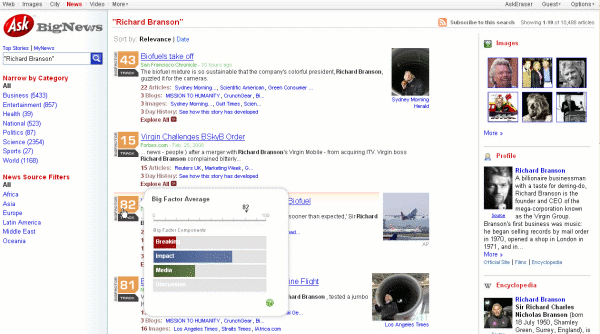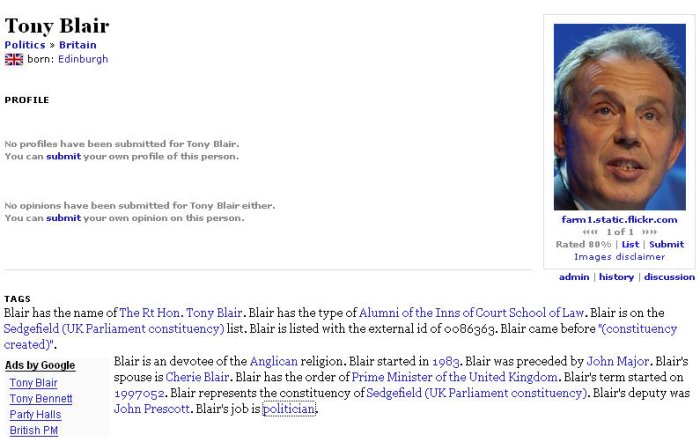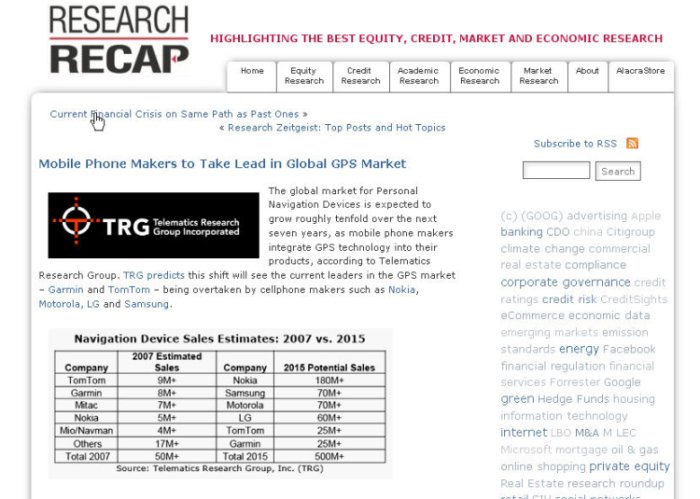Color Pencils Reviewed is an excellent review of a technology that is little used these days: colour (or color for US spelling) pencils. You can tell I am getting bored stuck in my hotel room!
All posts by Karen Blakeman
Ask updates news service
Ask (http://news.ask.com/) has updated it news service to ‘Big News’. Search results look very much like Ask’s web search with an option to narrow by category and suggestions on other types of resources you might like to view such as images, profiles and encyclopedia entries. In addition you can filter the sources by region for example Europe, Middle East, Oceania. Results are automatically sorted by relevance, and stories about the same topic or event are clustered together. You can, if you wish, choose to sort your results by date.
The most obvious change, though, is the numeric “Big Factor” ranking that appears next to each groups of stories or event. This analyses four aspects of the event:
- Breaking: timeliness of a story, with more weight given to breaking news
- Impact: the story’s impact across the web, which includes references in articles, multimedia, and blogs
- Media: the number of images and videos associated with the story
- Discussion: how much buzz a current event is generating in forums and other discussion areas
Scores range from 1-100 and you can display a graph of the relative importance of each of the factors by moving your cursor over the score. Click on the score and Ask displays the news articles, blogs, images and videos related to the event. I am finding this a really useful feature and a quick way of identifying videos of news and interviews on the story. If you want to monitor this particular story, click on the “Track” link that is part of the Big Factor score icon and you can add the RSS feed to your favourite feed reader. If you want regular updates on your entire search, at long last you can have an RSS feed on that as well.

The lack of RSS alerts has been the main reason why I have not regularly used Ask News in the past, but the availability of feeds plus the innovative features they have now introduced have convinced me to add them to my main collection of current news sources. A long time coming but well worth the wait. I do have one niggle – don’t I always?!- Big News is only available on the .com site. The UK site has the same old interface and results: I have to remember to enter news.ask.com as the URL. As with other developments and new features that they have introduced, I hope that they will roll this one out onto the UK site soon.
The Reality of Web 2.0 – free presentation at BBOD
I shall be giving a presentation for the Berks, Bucks and Oxon District of CILIP next week on the “The Reality of Web 2.0”. The date and time is Tuesday 4th March 18.00 for 18.30 and the venue Great Expectations, 33 London Street, Reading, Berkshire RG1 4PS www.streetmap.co.uk/newmap.srf?x=471801&y=173139&z=0&ar=Y. BBOD meetings are free and open to all with a professional interest in the topic. Refreshments provided afterwards.
The name of the venue is appropriate given the topic! I shall be looking at how far, or even if, the technologies have actually delivered in terms of improved productivity and usefulness. The publicity blurb is as follows:
“Now that the hype of Web 2.0 ‘stuff’ has died down, how useful has it turned out to be in practice and what impact has it had on the way we work? Karen Blakeman reviews the successes and failures and will look at applications such as Facebook, Second Life, start pages, social bookmarking, Twitter and Slideshare. Where do they fit on the Gartner hype cycle: are we down in the trough of disillusionment, or slowly making our way up the slope of enlightenment to the plateau of productivity? “
The event is free but please inform Norman Briggs, BBOD Events Co-ordinator nwbriggs@cix.co.uk
or Chrissy Alcott, BBOD Chair Chrissy.Allott@berkshire.nhs.uk if you plan to attend.
Conference: INFORUM 2008 – call for papers
Deadline: Thursday, February 21st
Venue: University of Economics in Prague, Czech Republic, May 28th to 30th, 2008.
http://www.inforum.cz/en/
The 14th INFORUM conference, organised by Albertina icome Praha and University of Economics, will be held in Prague, Czech Republic, from May 28-30, 2008.
The three-day conference is focused on variety of aspects concerning the use of electronic information resources in research, development, education and business,
Information specialists from academic, public and special libraries, corporate sector and government agencies can take part in this event, either as authors or as participants. The conference is open to the entire international research community. The conference is the main event in this field in the Czech and Slovak republics and in 2003 we extended it’s focus also to countries of Central and Eastern Europe. There were 56 invited and contributed papers and over 630 participants last year.
If you are interested in taking part in the conference, either as a speaker or as a participant, you can find detailed information at the INFORUM 2008 website http://www.inforum.cz/en/ (which includes main conference topics, paper submission form, etc.). Papers are now being invited for inclusion in the INFORUM 2008 programme. An extended abstract should be submitted on or before February 21, 2008. The abstracts should be informative enough to allow for an evaluation of the scientific value of the paper.
Conference topics http://www.inforum.cz/en/topics/
- Trends and Updates in the Field of Electronic Information Resources
- Digital Libraries – Trends, Technologies, Solutions
- Sharing and Flowing of Information in Business Sector
- Operational Aspects of Using Electronic Information Resources
- Electronic Information Resources in e-learning and e-learning in Electronic Information Resources
- Searching the Web and Heterogeneous Information Resources for Institutions
- Evaluation of Results of Scientific Research with a Help of Electronic Information Resources
The delegate’s registration forms will be available along with the preliminary conference programme by the beginning of March 2008.
The INSOURCE Conference Twitter Experiment
As mentioned earlier in my blog I was at INSOURCE 2008, 5th-6th February and twittering it. I would not normally Twitter a conference; my usual approach is to record nuggets of information and interesting sites in a Word document on my laptop. On this occasion, though, two colleagues who were not able to attend asked if I would Twitter it so that they could ‘follow’ me and get a flavour of the event. Right from the start I made it clear to them that I was not going to tap in every piece of information from the slide presentations. Most of the presentations are now available on the INSOURCE web site as PowerPoints and some as Word documents. Instead I concentrated on noting down snippets and web sites that I especially wanted to remember and significant comments from the speakers that were not on the slides.
For such an experiment to work one must have a laptop with a reasonably long battery ‘life’ – or easy access to a power socked for recharging during the breaks – and a reliable wi-fi connection. Those criteria were met at this conference (and the wi-fi was free!) but there was one unforeseen problem. The languages of the conference were Czech and English, which meant that I had to use head phones to listen to the simultaneous translations for the Czech papers. Unfortunately the reception on the head sets was frequently disrupted by static apparently caused by nearby laptops, wi-fi connections, mobile phones etc. Luckily, Marydee Ojala was attending the conference and was not as badly affected by the static as me, so she was often able to twitter on when I could not.
Aside from the technical disruption, how did we fare? Both Marydee and I are relatively new to twittering so much of the time early on was spent discovering how the whole thing works. For us the main issues were:
1. The 140 character limit on tweets (entries, postings, updates – whatever). At first this seemed to be a serious limitation but it does concentrate the mind wonderfully and you learn to note just the essentials. In comparison, my previous Word records of conferences appear verbose and full of waffle.
2. The ‘timelines’ or pages are public so one must be careful not to make libellous comments or offend people. It is possible to ‘lock’ your updates/tweets so that only selected followers can see them. If you prefer, you can send private messages to one another – a bit like passing notes in class (now that dates me!).
3. Not all of Marydee’s tweets appeared in my timeline and vice versa. This really did become very annoying as we had to periodically look at each other’s page to check what the other person had said. I have since discovered that this is a known bug and that Twitter is working on it. See The Case of the Missing Updates and Weekend Update on the Twitter Blog.
4. Both Marydee and I are concerned as to how long the tweets remain on the site. You can view the most recent 200 tweets on a page or in your own timeline but there is no mention of any expiration date. 200 may seem a lot but if there are several of you following each other at a conference, you quickly exceed that limit and have to resort to looking at individual pages for the older tweets. For me, that defeats the object of following conferences on Twitter. It is far more interesting and useful to see tweets on the same presentation from different people intermingled. The 200 limit also means that if you want to keep them as a permanent record for even just a few weeks you have to copy the tweets to a locally held document. There is no export facility.
Marydee and I twittered the INSOURCE conference together by ‘following’ each other. Apart from the technical glitches this worked reasonably well. However, if more people were involved it would be far too cumbersome to identify all the twitterers at a conference and follow them. But Twitter have thought of that – see Using Twitter for Your Event. That will be our next Twitter experiment 🙂
You can see Marydee’s INSOURCE twitterings at http://twitter.com/marydeeo and mine at http://twitter.com/karenblakeman.
Update on the conference twittering experiment
Twittering (or is it tweeting) the INSOURCE conference in Prague generally went well. It helped me concentrate on the presentations more, and I really got into the swing of it once I had become accustomed to the 140 character limitation on each tweet. The only problem I had was with some of the Czech presentations. The headphones for the English translations were subject to static from nearby laptops and the wi-fi connections. At one point my headphones gave up altogether. Marydee Ojala, who is also here and twittering, took over from me and then joined in full time. So there are two threads of the conference on twitter.com: my own (karenblakeman) and Marydee’s (marydeeo).
Twittering is about to re-start at 8.30 Czech time, 7.30 UK time.
Twittering at INSOURCE 2008
I shall be in Prague this week twittering from INSOURCE 2008. This is a new conference entitled ‘Conference on Professional Information Resources for business, Marketing, Management, Research. Several of my colleagues have asked for feedback on the event but rather than do a formal report I shall attempt to twitter it. The problem with events such as these is that I start off with the best intentions to attend as many presentations as possible but end up instead chatting to various people.
Details of the event are on http://www.insource.cz/ and the papers will, I understand, appear on the web site.
Tinfinger people search
Phil Bradley was not very complimentary in his blog about Tinfinger, a people search tool. His search on Gordon Brown, the current UK prime minister, came up with an entry that had clearly been computer generated and which was full of inaccuracies. Tinfinger’s Paul Montgomery confirmed in a comment to Phil’s posting that a lot of the content is pre-generated, but that the intention is for people to use that raw data to write full profiles.
It seems that Phil’s posting encouraged someone to update and correct Gordon Brown’s profile as the information is now correct – or was when I looked at it. Tony Blair’s is a different matter, though. There is no profile but there is a picture and several “tags”:
“Blair has the name of The Rt Hon. Tony Blair. Blair has the type of Alumni of the Inns of Court School of Law. Blair is on the Sedgefield (UK Parliament constituency) list. Blair is listed with the external id of 0086363. Blair came before “(constituency created)“. Blair is an devotee of the Anglican religion. Blair started in 1983. Blair was preceded by John Major. Blair’s spouse is Cherie Blair. Blair has the order of Prime Minister of the United Kingdom. Blair’s term started on 1997052. Blair represents the constituency of Sedgefield (UK Parliament constituency). Blair’s deputy was John Prescott. Blair’s job is politician.”
I would love to know from where that information was collected! It is early days for Tinfinger and hopefully people will get on board and start editing and creating more accurate profiles. At present it is an example of how wrong information can be when it is automatically generated, and the importance of being aware of how content is compiled.

Research Recap
Alacra’s Research Recap pulls together industry, economic, academic, market, investment and credit research reports. It concentrates on free content but also offers links to selected paid research deemed of relevance to the topic. Priced reports are sourced from a wide variety of providers, including the Alacra Store. Much of the paid research is usually password-protected and will not show up in a Google-type search, but Research Recap has made arrangements with providers to review their proprietary research to determine what is appropriate to highlight for Research Recap’s audience. Research Recap does not claim to be comprehensive and may not include items that are widely circulated elsewhere.
Research Recap is published in blog format and is also available as an RSS feed.

Edinburgh: home to the UK’s fastest supercomputer
This story, found on Silicon.com, really appeals to the geekishnes in me. Hector, High-End Computing Terascale Resource [what happened to the ‘o’?] , can handle 63 trillion calculations per second, which is the equivalent processing power of 12,000 desktop systems. The supercomputer is based at the University of Edinburgh’s Advanced Computer Facility and operated by the Edinburgh Parallel Computing Centre (EPCC). The sort of work that Hector will do includes forecasting the impact of climate change, projecting the spread of disease epidemics and developing new medicines. For those of us who are self-employed, though, the name Hector brings to mind the bowler hatted cartoon character that the UK Inland Revenue used in their adverts to exhort us to get our self-assessment tax forms and payments in on time.
Now for the serious techie stuff: Hector uses a Cray XT4 system with software and application support provided by NAG; Hector has a peak capability of 63 Teraflops but this is due to increase to 250 Teraflops in October 2009, with a further upgrade due two years later. Now you know:-)
On a global scale, though, Hector comes in at number 17. The TOP500 Supercomputing Sites lists the … erm … top 500 supercomputing sites. The November 2007 list is at http://www.top500.org/list/2007/11/100.